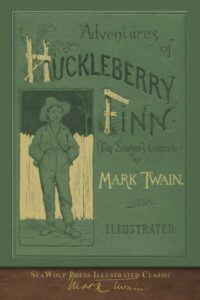
Book Summary
The Adventures of Huckleberry Finn is an exciting and funny book written by Mark Twain. It tells the story of a young boy named Huckleberry Finn and his adventures along the Mississippi River. Get ready to join Huck on a thrilling journey!
In this book, Huck Finn runs away from his mean father and meets a runaway slave named Jim. Together, they travel on a raft down the river, facing all sorts of challenges and meeting interesting people along the way. They have to be clever to escape from dangerous situations and even pretend to be someone else!
The Adventures of Huckleberry Finn is a very exciting story that will keep you on the edge of your seat. You will laugh at Huck’s funny adventures and feel worried when he gets into trouble. This book is full of surprises and will make you want to keep reading to find out what happens next!
The Adventures of Huckleberry Finn is not just an exciting story, it also teaches us important lessons. It shows us the importance of friendship and standing up for what is right, even when it’s difficult. Huck learns that people should be treated equally, no matter their skin color. This book also gives us a glimpse into what life was like in the past, when slavery was still a part of American history.
Mark Twain, the author of this book, was a very famous writer. He wrote many other books and stories that are loved by people all over the world. Mark Twain had a special way of writing that made his stories come alive, and The Adventures of Huckleberry Finn is one of his most famous works.
Mark Twain, whose real name was Samuel Clemens, was born in 1835 in Missouri, USA. He loved writing and became one of the greatest American authors of all time. Mark Twain wrote many books and stories that are still read and loved today. His writing style was funny and clever, and he often wrote about his own experiences growing up. Mark Twain’s books are considered classics and continue to be enjoyed by readers of all ages.
The Adventures of Huckleberry Finn is a seminal work of American literature penned by the renowned author Mark Twain. Published in 1884, the novel is often considered Twain’s masterpiece, offering a vivid depiction of life along the Mississippi River during the mid-19th century. The story is narrated by the titular character, Huckleberry Finn, a young boy who embarks on a journey of self-discovery and moral growth.
The Adventures of Huckleberry Finn is a compelling blend of humor, adventure, and profound social commentary. The novel’s narrative is driven by Huck’s journey down the Mississippi River with Jim, a runaway slave. Their shared experiences provide a critical examination of the societal norms and prejudices of the time. Twain’s use of vernacular language and dialects adds a layer of authenticity to the narrative, immersing readers in the cultural milieu of the era.
The novel’s strength lies in its characters, particularly Huck and Jim. Huck, with his rebellious spirit and innate sense of justice, challenges the moral conventions of his society. Jim, on the other hand, is a symbol of humanity and dignity in the face of racial prejudice. Their evolving relationship forms the emotional core of the story.
Despite its controversial nature due to its depiction of racial stereotypes and use of racial slurs, The Adventures of Huckleberry Finn remains a significant work in American literature for its exploration of themes such as freedom, friendship, and the hypocrisy of civilized society.
The Adventures of Huckleberry Finn is a complex work that explores a multitude of themes. At its heart, it is a coming-of-age story, chronicling Huck’s moral and psychological development as he grapples with the societal norms of his time. The river journey serves as a metaphor for Huck’s journey towards moral enlightenment, with the river itself symbolizing freedom and the raft representing a sanctuary from the oppressive society.
The novel also offers a scathing critique of the society Huck and Jim navigate. Twain uses satire and irony to expose the hypocrisy and moral bankruptcy of the so-called “civilized” society. The portrayal of slavery and racial prejudice is particularly poignant, highlighting the inhumanity and injustice inherent in these institutions.
Twain’s use of dialects and vernacular language not only adds authenticity to the narrative but also serves as a tool for characterization and social commentary. The language used by the characters reflects their social status, education level, and regional background, providing insights into the social stratification of the era.
Mark Twain, whose real name was Samuel Langhorne Clemens, was born in 1835 in Florida, Missouri. He is one of the most celebrated figures in American literature, known for his wit, humor, and keen social commentary. Twain’s works often draw from his experiences growing up along the Mississippi River and his adventures as a steamboat pilot, a gold miner, and a journalist.
Twain’s other notable works include The Adventures of Tom Sawyer, Life on the Mississippi, and A Connecticut Yankee in King Arthur’s Court. His unique narrative style, characterized by humor, colloquial language, and vivid descriptions, has had a profound influence on American literature. Twain passed away in 1910, but his legacy continues to live on through his works.
Don Quixote by Miguel de Cervantes
Miguel de Cervantes
Read Now →